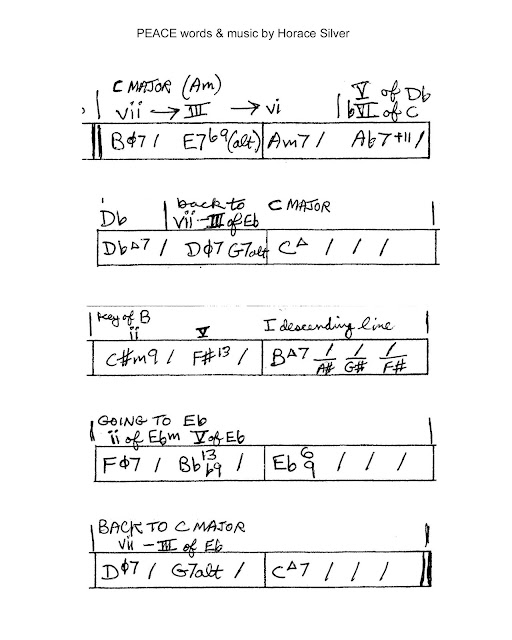Although
Horace wrote and recorded Peace as an instrumental in Bb, there is a
wonderful vocal version by Lonnie Liston Smith. Donald Smith's vocal is
splendid, and it was necessary to move to the key to C to accommodate
his low G at the end of the piece.
The
L. L. Smith version features a split keyboard allowing a string "wash"
to complement the vocal, creating a 70s fusion feel. A
lovely ballad with a great message - Horace wrote lyrics to many of his
songs even though they were recorded instrumentally by his combo.
I've
puzzled over exactly what is the guiding harmonic thought on the rubato
beginning and the ending chord that allows the F# on the I chord (C
major). My workaround is to simply use Bm/G (G Maj7) for the intro and
ending chord. It might be considered as Cmaj7b5 but I think G Maj7 works
OK.
The song is 10 measures at a
slow tempo. At first glance one wonders, "how can I possibly remember
this?" But after a few repetitions it becomes an easy and fun piece to
play. I find it advantageous to look at this song in two measure
segments:
After the initial
rubato chord, letter "A" starts in the key of C major. The vocal pickup
leads to an F natural, and the first chord is the vii of C major
followed by an E7 altered dominant (V7 of vi minor) on beats 3 & 4.
In measure 2 we get an Am7 followed by an Ab7. In the key of C that Ab7
would be a Lydian dominant leading down a half step, and instead we get a
"surprise" chord to start measure 3.
Measures
3 & 4 feature a quick modulation back to C major after a short
visit to Db major on the first two beats of bar 3. Beats 3 & 4 are a
quick ii-V going back to C major in bar 4. The ii-V looks like it's
going to resolve to Cm because it's vii-III7alt of Eb (relative major of
C minor) and the C major chord of measure 4 is again a "surprise"
chord.
The bass moves up a
half-step to start measure 5 on a C#m9, beats 1 & 2, followed by an
F#13, beats 3 & 4. The C#m9 could be voiced as E Maj7/C# and the
F#13 could by voiced as E Maj7b5/F# - the only moving tone between those
two chords would be B natural to B flat (A sharp of the F#13).
Measure
6 can be played several ways. First time around use a descending bass
line B-A#-G#-F# under a B major I chord. Second time stay on B two beats
then use the same descending run B-A#-G#-F# as eighth notes. A third
method, behind solos, don't use the walk down...
Measures
5 & 6 were in the key of B major. Measure 7 is a modulation to Eb
major. The F half-diminished is like a ii chord in Eb minor (vii of Gb) ,
but the choice of Bb13b9 leads nicely to an Eb69 for a I chord - again,
a surprise chord. The listener was set up for a modulation to Eb minor
but instead receives a lush Eb major. After a long slow 8 bars all that
is left is to modulate back to C major.
Magically,
in measure 9 we can evoke a vii-III7alt in the key of Eb (Dm7b5 -->
G7alt), 2 beats on each chord, and then we're back home to C major as a
surprise chord (instead of C minor). And we choose C Maj7 to represent
the I chord for the four beats of measure 10 - although C6 or C69 could
also work to define the "home" chord.
The
last time through do a rubato repeat of measure 9 with fermatas over
the Dm7b5 and G7alt chords. Follow the singer carefully, it's a long
descending run to a low G! Then use Bm/G as the last chord. Peace!
By the way, these charts are saved as jpegs, and they can be easily downloaded.







No comments:
Post a Comment